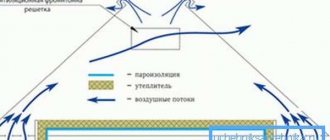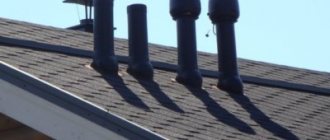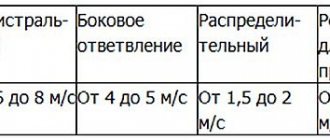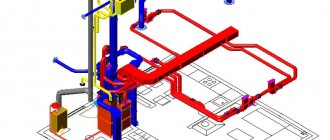Online calculator for calculating ventilation performance
Calculation of ventilation, as a rule, begins with the selection of equipment that is suitable for such parameters as performance in terms of the volume of air pumped and measured in cubic meters per hour. An important indicator in the system is the air exchange rate. The air exchange rate shows how many times the air in the room is completely replaced within an hour. The air exchange rate is determined by SNiP and depends on:
- purpose of the premises
- quantity of equipment
- generating heat,
- number of people in the room.
In total, all values for the air exchange rate for all rooms constitute the air productivity.
Calculation of productivity by air exchange rate | Methodology for calculating ventilation by multiplicity: L = n * S * N, where: L—required productivity m3/h; n is the air exchange rate; S is the area of the room; H—room height, m. | |
Calculation of ventilation performance by number of people | ||
| Methodology for calculating ventilation performance by number of people: L = N * Lnorm, where: L—capacity m3/h; N is the number of people in the room; Lн - standard indicator of air consumption per person component: during rest - 20 m3/h; during office work - 40 m3/h; during active work - 60 m3/h. | ||
Features of determining the length of ventilation pipes
Another important parameter when designing ventilation systems is the length of the outer pipe. It unites all the channels in the house through which air circulates and serves to remove it outside.
Calculation according to the table
The height of the ventilation pipe depends on its diameter and is determined from the table. Its cells indicate the cross-section of the air ducts, and the column on the left shows the width of the pipes. Their height is indicated in the top line and is indicated in mm.
Selecting the height of the ventilation pipe according to the table
In this case, you need to take into account:
- If the ventilation pipe is located next to the chimney, then their heights must match to avoid smoke penetration into the premises during the heating season.
- When the air duct is located from the ridge or parapet at a distance that does not exceed 1.5 m, its height must be more than 0.5 m. If the pipe is located within 1.5 to 3 m from the roof ridge, then it cannot be lower his.
- The height of the ventilation pipe above a flat roof cannot be less than 0.5 m.
Location of ventilation pipes relative to the roof ridge
Using the Software
An example of calculating natural ventilation using special programs
Calculating natural ventilation is less labor-intensive if you use a special program for this. To do this, first determine the optimal volume of air flow, depending on the purpose of the room. Then, based on the data obtained and the features of the designed system, a calculation of the ventilation pipe is made. In this case, the program allows you to take into account:
- average temperature inside and outside;
- geometric shape of air ducts;
- roughness of the internal surface, which depends on the material of the pipes;
- resistance to air movement.
Online calculator for calculating the ventilation system
The next stage in the calculation of ventilation is the design of an air distribution network, consisting of the following components: air ducts, air distributors, fittings (adapters, turns, splitters.)
First, a ventilation duct diagram is developed, which is used to calculate the noise level, network pressure and air flow speed. The network pressure directly depends on the power of the fan used and is calculated taking into account the diameters of the air ducts, the number of transitions from one diameter to another, and the number of turns. The pressure through the network should increase with the length of the air ducts and the number of turns and transitions.
Calculation of the number of diffusers
| Methodology for calculating the number of diffusers N = L / ( 2820 * V * d * d ), where N—number of diffusers, pcs; L—air flow, m3/hour; V—air velocity, m/sec; d — diffuser diameter, m. | ||
Calculation of the number of gratings | ||
| Method for calculating the number of gratings N = L / ( 3600 * V * S ) where N—number of gratings; L—air flow, m3/hour; V—air velocity, m/sec; S is the live cross-sectional area of the grating, m2. | ||
When designing ventilation systems, it is necessary to find the optimal balance between fan power, noise level and the diameter of the air ducts. Calculation of the heater power is made taking into account the required temperature in the room and the lower level of air temperature outside.
Calculation of heater power
| Method for calculating heater power P = T * L * Cv / 1000, where: P—device power, kW; T—temperature difference at the outlet and inlet of the system, °C; L - productivity m?/h. Cv - volumetric heat capacity of air = 0.336 Wh/m?/°C. The supply voltage can be single-phase 220 V or three-phase 380 V. With a power of more than 5 kW, it is advisable to use a three-phase connection. |
Also, when choosing equipment for the ventilation system, it is necessary to calculate the following parameters:
- Air performance;
- Heater power;
- Operating pressure created by the fan;
- Air flow speed and cross-sectional area of air ducts;
- Permissible noise level.
How to calculate the diameter and length of ventilation pipes
One of the conditions for creating a comfortable microclimate in residential and industrial premises is the presence of an engineering system that ensures air circulation. To ensure its effective operation, it is necessary to correctly calculate the length and diameter of the ventilation pipe. To do this, several methods are used, depending on the characteristics of the engineering system.
Ventilation diagram for a private house
Examples of air exchange volume calculations
To calculate the ventilation system by multiples, you first need to make a list of all the rooms in the house, write down their area and ceiling heights.
For example, a hypothetical house has the following rooms:
- Bedroom – 27 sq.m.;
- Living room – 38 sq.m.;
- Office – 18 sq.m.;
- Children’s room – 12 sq.m.;
- Kitchen – 20 sq.m.;
- Bathroom – 3 sq.m.;
- Bathroom – 4 sq.m.;
- Corridor – 8 sq.m.
Considering that the ceiling height in all rooms is three meters, we calculate the corresponding air volumes:
- Bedroom – 81 cubic meters;
- Living room – 114 cubic meters;
- Cabinet – 54 cubic meters;
- Children’s room – 36 cubic meters;
- Kitchen – 60 cubic meters;
- Bathroom – 9 cubic meters;
- Bathroom – 12 cubic meters;
- Corridor – 24 cubic meters.
Now, using the table above, you need to calculate the ventilation of the room, taking into account the air exchange rate, increasing each indicator to a multiple of five:
- Bedroom – 81 cubic meters*1 = 85 cubic meters;
- Living room – 38 sq.m.*3 = 115 cubic meters;
- Cabinet – 54 cubic meters*1 = 55 cubic meters;
- Children's room - 36 cubic meters * 1 = 40 cubic meters;
- Kitchen – 60 cubic meters. – not less than 90 cubic meters;
- Bathroom – 9 cubic meters. not less than 50 cubic meters;
- Bathroom – 12 cubic meters. not less than 25 cubic meters
There is no information about the standards for the corridor in the table, so the data for this small room is not taken into account in the calculation. For the living room, a calculation of the area was carried out taking into account the standard of three cubic meters. meters for every meter of area.
Now you need to separately summarize the information on the rooms in which air flows, and separately on the rooms where exhaust ventilation devices are installed.
Air exchange volume by inflow:
- Bedroom – 81 cubic meters*1 = 85 cubic meters/hour;
- Living room – 38 sq.m.*3 = 115 cubic meters/hour;
- Cabinet – 54 cubic meters*1 = 55 cubic meters/hour;
- Children’s room – 36 cubic meters*1 = 40 cubic meters/hour;
Total : 295 cubic meters per hour.
Exhaust air exchange volume:
- Kitchen – 60 cubic meters. — not less than 90 cubic meters/h;
- Bathroom – 9 cubic meters. — not less than 50 cubic meters/h;
- Bathroom – 12 cubic meters. — not less than 25 cubic meters/hour.
Total : 165 cubic meters/hour.
Now you should compare the amounts received. It is obvious that the required inflow exceeds the exhaust by 130 cubic meters per hour (295 cubic meters per hour - 165 cubic meters per hour).
To eliminate this difference, you need to increase the volume of air exchange through the hood, for example, by increasing the indicators in the kitchen. In practice, this is done, for example, by replacing air ducts with channels of a larger cross-section.
How to choose the cross-section of the air duct?
The ventilation system, as is known, can be ducted or ductless. In the first case, you need to choose the right channel cross-section. If a decision is made to install structures with a rectangular cross-section, then the ratio of its length and width should approach 3:1.
The standard speed of movement of air masses along the main ventilation duct should be about five meters per second, and on branches - up to three meters per second. This will ensure the system operates with minimal noise. The speed of air movement largely depends on the cross-sectional area of the duct.
To select the dimensions of the structure, you can use special calculation tables. In such a table, you need to select the air exchange volume on the left, for example, 400 cubic meters per hour, and select the speed value at the top - five meters per second.
Then you need to find the intersection of the horizontal line for air exchange with the vertical line for speed.
From this intersection, draw a line down to a curve from which a suitable section can be determined. For a rectangular duct this will be the area, and for a round duct this will be the diameter in millimeters. First, calculations are made for the main air duct, and then for the branches.
Thus, calculations are made if only one exhaust duct is planned in the house. If it is intended to install several exhaust ducts, then the total volume of the exhaust duct must be divided by the number of ducts, and then calculations must be made according to the stated principle.
In addition, there are specialized calculation programs that can be used to perform such calculations. For apartments and residential buildings, such programs can be even more convenient, since they give a more accurate result.
Normal air exchange is influenced by such a phenomenon as reverse draft, the specifics of which and ways to combat it will be introduced in the article we recommend.
How to calculate air exchange?
All calculations for ventilation systems come down to determining the volume of air in the room. Such a room can be considered either a separate room or a collection of rooms in a particular house or apartment.
Based on these data, as well as information from regulatory documents, the main parameters of the ventilation system are calculated, such as the number and cross-section of air ducts, fan power, etc.
There are specialized calculation methods that allow you to calculate not only the renewal of air masses in a room, but also the removal of thermal energy, changes in humidity, removal of contaminants, etc. Such calculations are usually performed for industrial, social or any specialized buildings.
If there is a need or desire to perform such detailed calculations, it is best to contact an engineer who has studied such techniques.
For independent calculations for residential premises, use the following options:
- by multiples;
- according to sanitary and hygienic standards;
- by area.
All these methods are relatively simple; once they understand their essence, even a non-specialist can calculate the basic parameters of their ventilation system. The easiest way is to use area calculations. The following norm is taken as a basis: every hour three cubic meters of fresh air per square meter of area should enter the house.
The number of people who permanently live in the house is not taken into account.
Calculation according to sanitary and hygienic standards is also relatively simple. In this case, for calculations, it is not the area that is used, but data on the number of permanent and temporary residents.
For each permanent resident it is necessary to provide an influx of fresh air in the amount of 60 cubic meters per hour. If temporary visitors are regularly present in the room, then for each such person you need to add another 20 cubic meters per hour.










